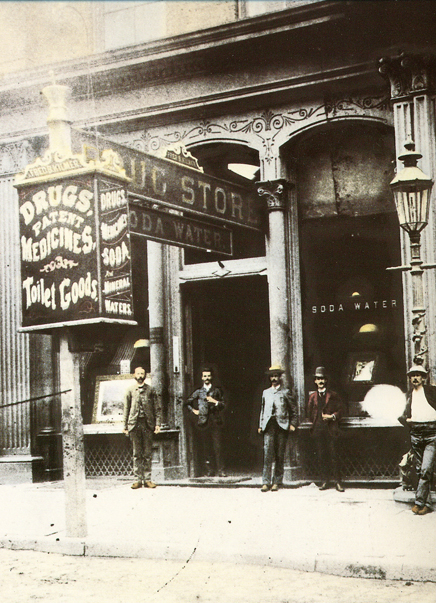Robert Wood Johnson at Home
In the earliest days of the Company, Johnson & Johnson was centered in the city of New Brunswick, where it still is headquartered today. Although the research labs were located across the river in Highland Park, the plaster making facilities, warehouses, cotton mill, shipping and other facilities were located close to the river in New Brunswick. Besides the Company’s World Headquarters (which still occupies roughly the same site at which the Company started), New Brunswick is home to other sites of historical significance to Johnson & Johnson. Like most of their employees, the Johnson family lived in New Brunswick. Robert Wood Johnson the first and his family lived in a Victorian house called Gray Terrace on the corner of College Avenue and Hamilton Street, and James Wood Johnson and his family lived on Union Street, allowing the Johnson brothers to walk to work.

Gray Terrace, corner of College and Easton Avenues
Robert Wood Johnson married in 1892, and he and his wife Evangeline had three children: Robert Wood Johnson the second, born in 1893, John Seward Johnson, born in 1895 and Evangeline Brewster Johnson, born in 1897. They were joined at Gray Terrace by Johnson’s daughter Roberta from his first marriage.

Robert Wood Johnson the First
Every afternoon, Johnson walked the few blocks from Johnson & Johnson to Gray Terrace to have his main meal of the day with his family. (Robert Wood Johnson: The Gentleman Rebel, p. 67)

The children of Robert Wood Johnson, from left: Robert, Evangeline and Seward.
Johnson's house had three libraries filled with books, as well as greenhouses where Johnson and his gardeners grew a wide variety of flowers, including rare orchids. Once a New Brunswick landmark, Robert Wood Johnson’s house is no longer standing. Toward the end of its history, it became a Rutgers University fraternity house and the site is now a Rutgers University parking lot.
Site of Gray Terrace Today
The house may be gone, but the low stone wall that surrounded it, topped by a short wrought-iron fence, is still there.
Scientific Director Fred Kilmer’s house, at 17 Joyce Kilmer Avenue, is an historic site. The street was called Codwise Avenue when the Kilmers lived there from approximately 1886 to 1892; its name was changed to commemorate Fred Kilmer’s son Alfred Joyce Kilmer, the well-known poet who was killed in World War I. Joyce was born in that house in New Brunswick in 1886, the same year Johnson & Johnson was founded. Here’s a link to a website by Joyce’s granddaughter (and Fred Kilmer’s great-granddaughter), with more information about Joyce Kilmer. Both Joyce Kilmer and Robert Wood Johnson’s eldest son Robert (who would later become known as General Johnson) attended Rutgers Preparatory School on Easton Avenue, another local landmark with connections to Johnson & Johnson.
Here’s a section from an old map of New Brunswick in May of 1886. If you look closely at the big building on the corner of George and Albany Streets, in front of the section marked “Opera House,” the subdivision on the right is marked “Drugs,” which means that it very likely shows the location of Fred Kilmer’s Opera House Pharmacy (shown below), which he owned before joining Johnson & Johnson.

If so, then that makes the corner of Albany and George Streets (across Albany Street from the 410 George Street building) another New Brunswick landmark with connections to the Company.

Hi all!
Great book. I just want to say what a fantastic thing you are doing! Good luck!
G'night
Hi
Looks good! Very useful, good stuff. Good resources here. Thanks much!
G'night
I love the site.
What happened to Gray Terrace? Did it burn? Why was it razed?
I once spoke with a woman who's dad was the Johnson's coachman.
She was very old and lived on Morrell St. She spoke fondly of Gray Terrace.
Answer my email if you would pls.
Rick
Hi Rick,
I'm glad you like the blog! Gray Terrace eventually became a Rutgers University fraternity house for the Kappa Sigma fraternity. Eventually, it was torn down, but I don't know the year. When Robert Wood Johnson the first lived there, Gray Terrace had greenhouses, in which Johnson grew orchids, as well as a barn which housed a pony for the Johnson children. Johnson also had three libraries in the house filled with books. Your conversation with the woman whose father was the Johnson's coachman must have been fascinating. Interestingly enough, Johnson & Johnson had some subsidized housing for employees on Morell Street over a century ago. Gray Terrace predated the Johnson family. I believe it was built in the 1870s, and there was a legend that gold from a famous robbery was hidden between its walls; the legend was of course not true, but the story goes that many fraternity pledges were sent between the walls looking for the phantom gold.
Margaret
This is a great website. Do you plan to publish a book about J&J and New Brunswick?